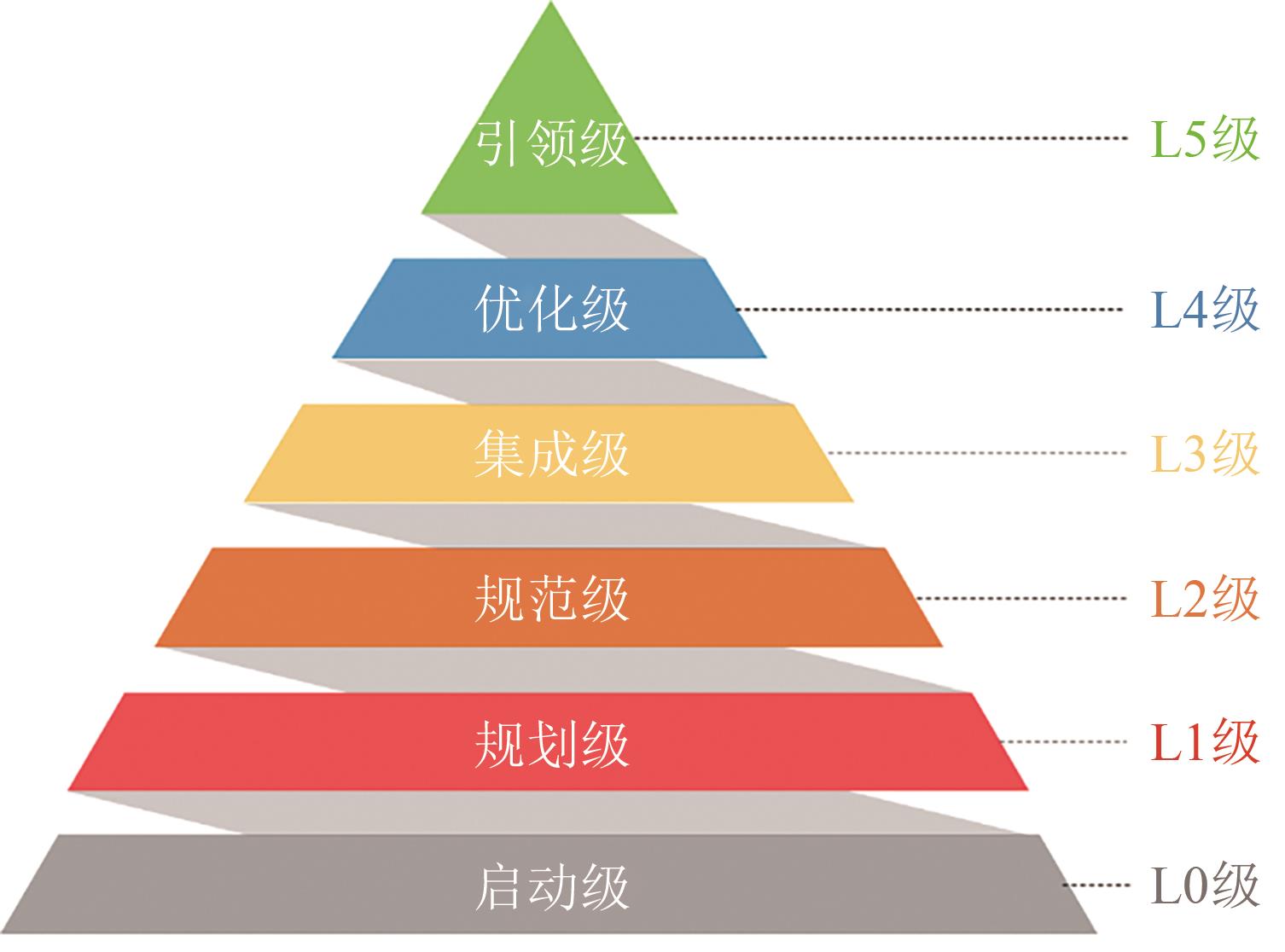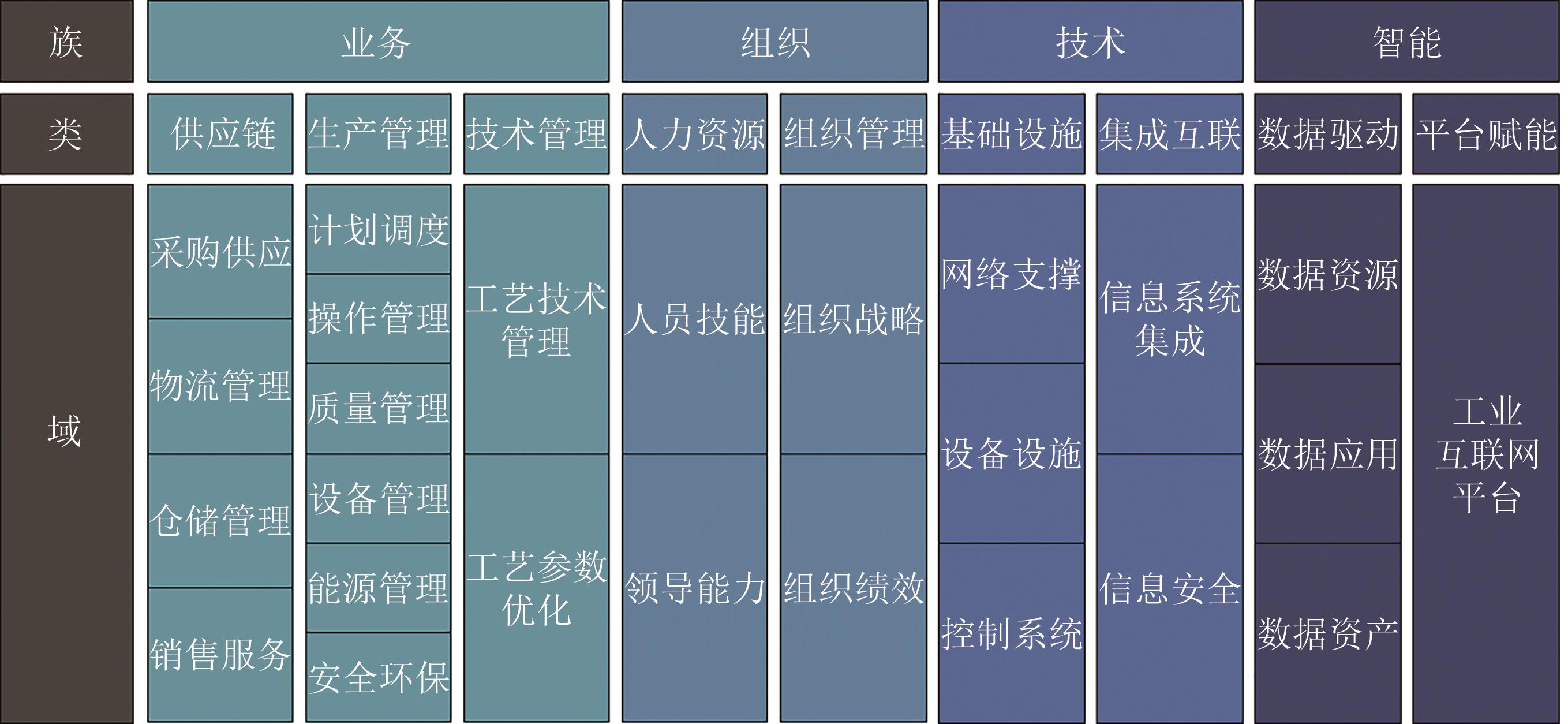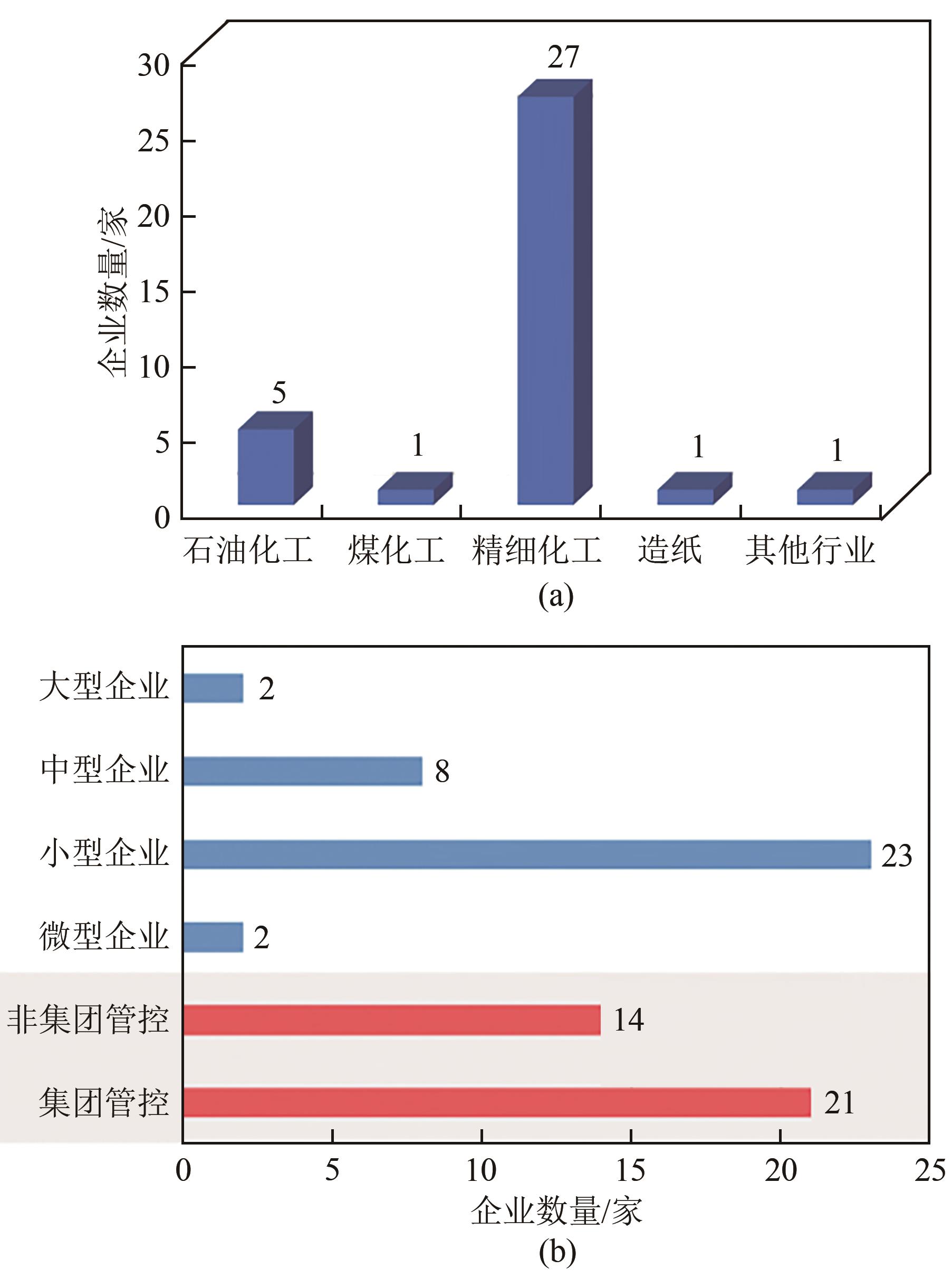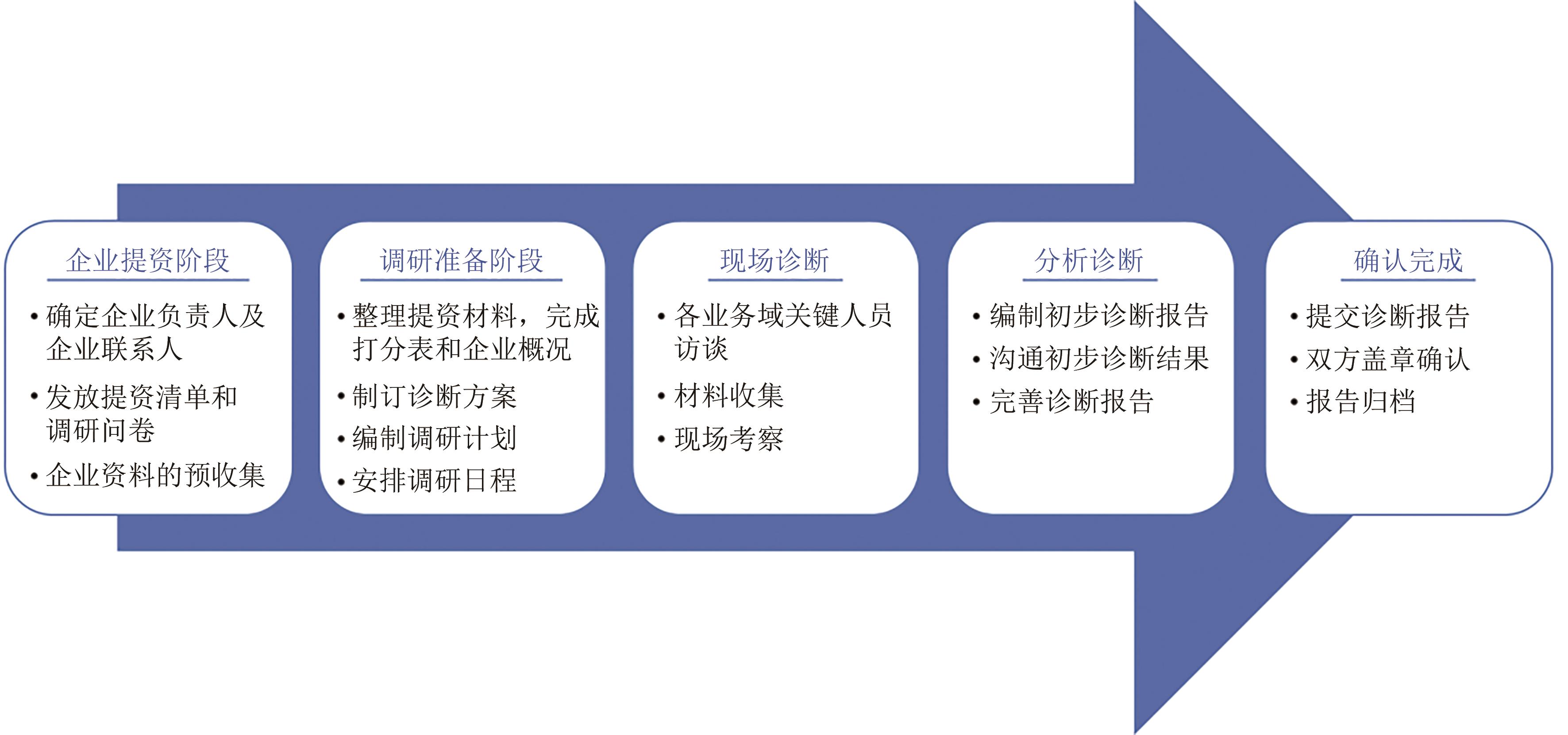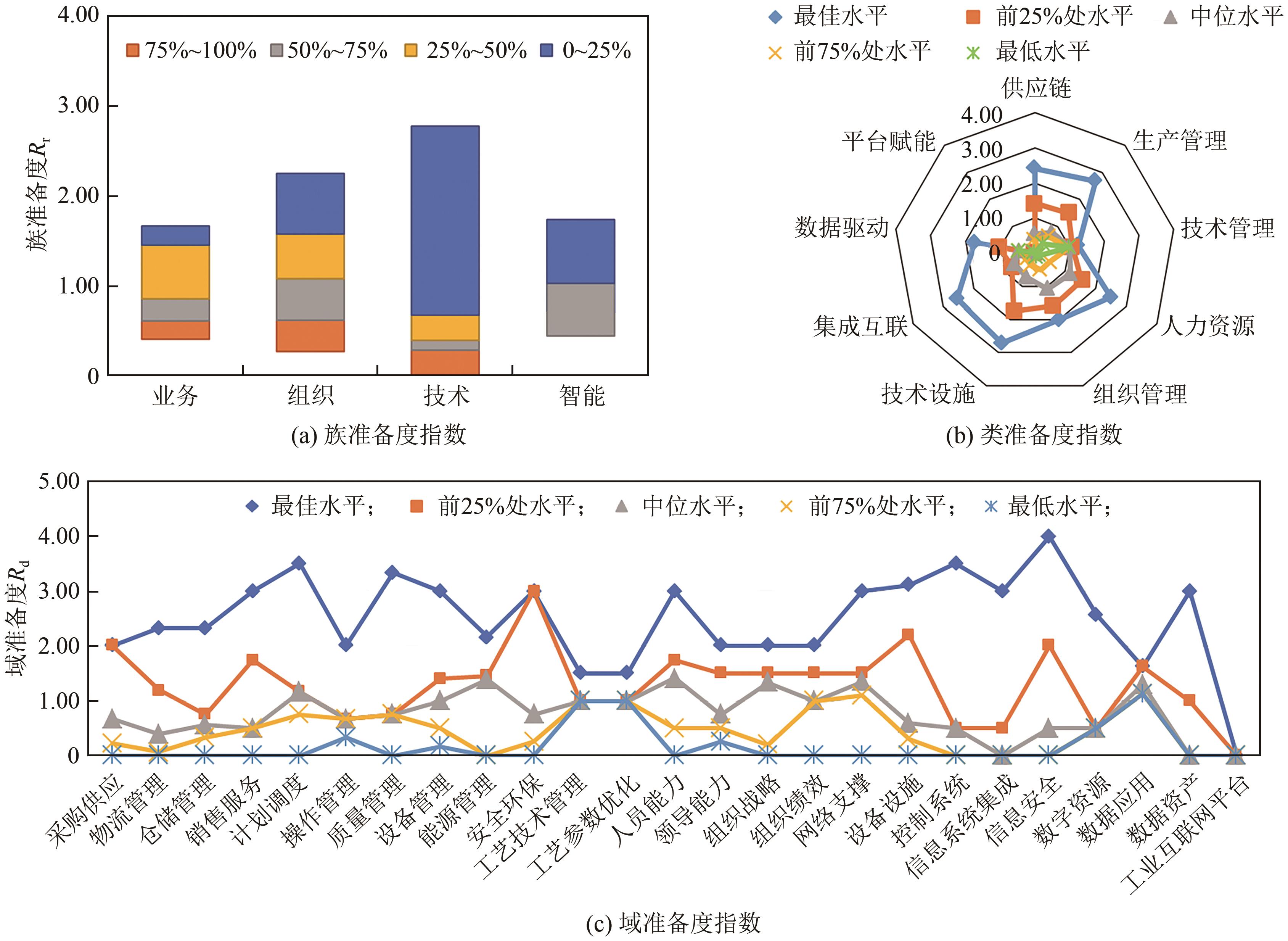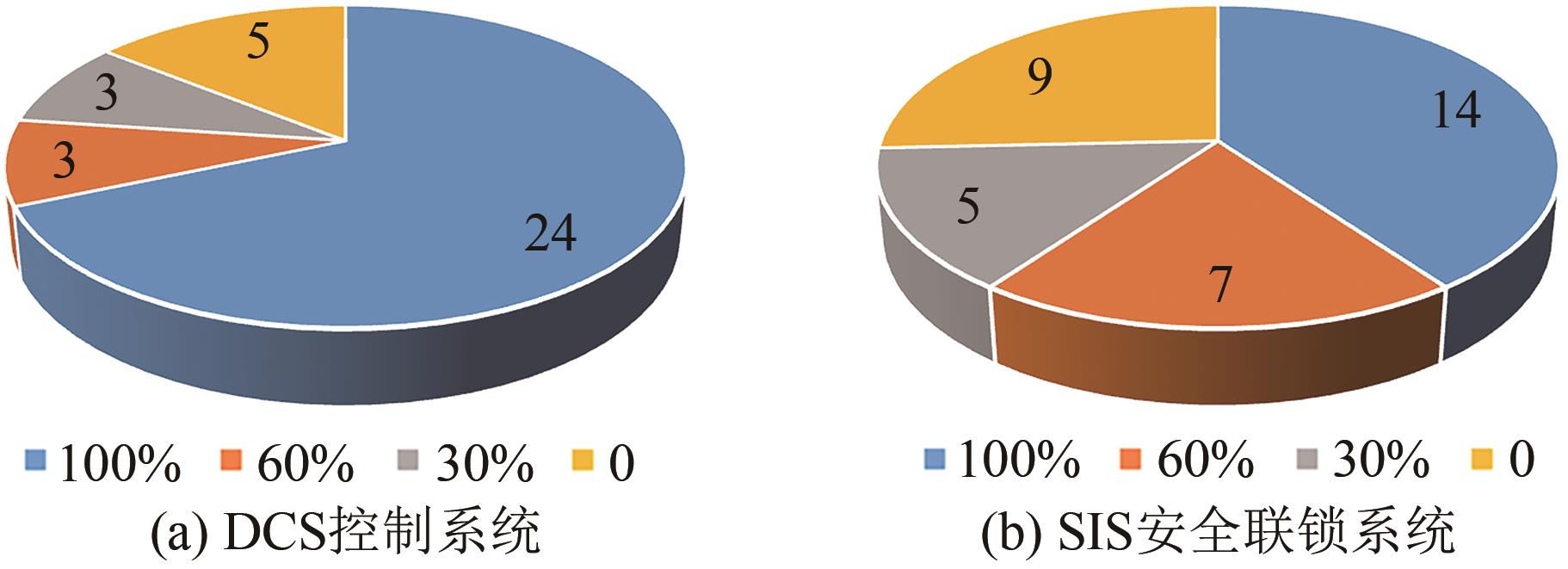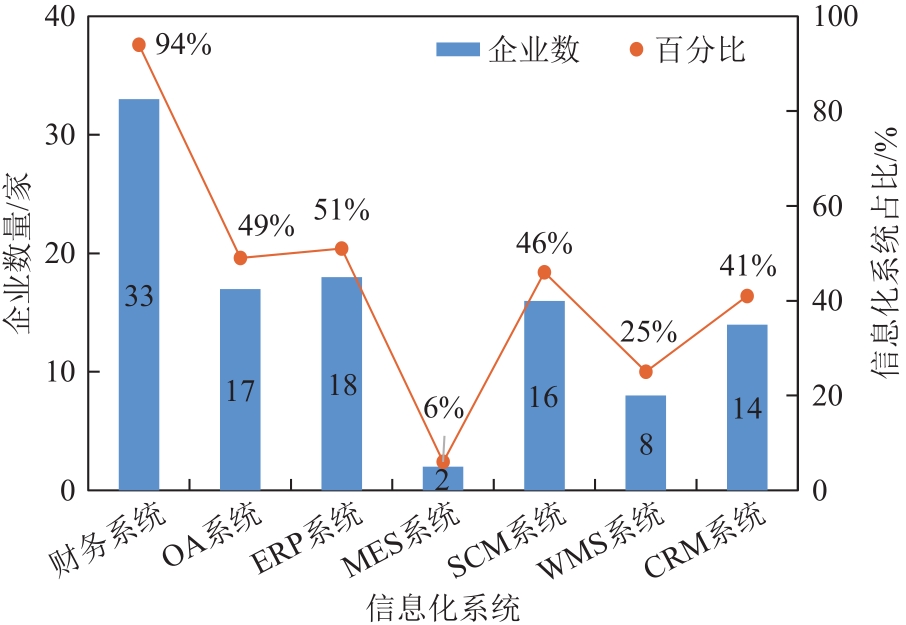Chemical Industry and Engineering Progress ›› 2023, Vol. 42 ›› Issue (1): 118-127.DOI: 10.16085/j.issn.1000-6613.2022-0560
• Chemical processes and equipment • Previous Articles Next Articles
Model and practice of the intelligent manufacturing readiness for process industry
ZHAO Lujun1,2( ), QI Yuqi2, SHAO Jiaming2,3, CHU Jian2, WANG Zhihua3, FENG Yiping1(
), QI Yuqi2, SHAO Jiaming2,3, CHU Jian2, WANG Zhihua3, FENG Yiping1( )
)
- 1.State Key Laboratory of Industrial Control Technology, College of Control Science and Engineering, Zhejiang University, Hangzhou 310027, Zhejiang, China
2.Zhejiang SUPCON Technology Co. , Ltd. , Hangzhou 310053, Zhejiang, China
3.State Key Laboratory of Clean Energy Utilization, Zhejiang University, Hangzhou 310027, Zhejiang, China
-
Received:2022-04-04Revised:2022-06-28Online:2023-02-20Published:2023-01-25 -
Contact:FENG Yiping
流程工业智能制造准备度模型及应用实践
赵路军1,2( ), 祁雨奇2, 邵嘉铭2,3, 褚健2, 王智化3, 冯毅萍1(
), 祁雨奇2, 邵嘉铭2,3, 褚健2, 王智化3, 冯毅萍1( )
)
- 1.浙江大学智能系统与控制研究所,浙江 杭州 310027
2.浙江中控技术股份有限公司,浙江 杭州 310053
3.浙江大学能源清洁利用国家重点实验室,浙江 杭州 310027
-
通讯作者:冯毅萍 -
作者简介:赵路军(1975—),男,博士研究生,高级工程师,研究方向为企业信息化规划、流程工业智能工厂设计、流程工业生产执行系统解决方案、石油化工工艺仿真设计等。E-mail: zhaolj@supcon.com。 -
基金资助:国家重点研发计划(2019YFB1705004)
CLC Number:
Cite this article
ZHAO Lujun, QI Yuqi, SHAO Jiaming, CHU Jian, WANG Zhihua, FENG Yiping. Model and practice of the intelligent manufacturing readiness for process industry[J]. Chemical Industry and Engineering Progress, 2023, 42(1): 118-127.
赵路军, 祁雨奇, 邵嘉铭, 褚健, 王智化, 冯毅萍. 流程工业智能制造准备度模型及应用实践[J]. 化工进展, 2023, 42(1): 118-127.
share this article
Add to citation manager EndNote|Ris|BibTeX
URL: https://hgjz.cip.com.cn/EN/10.16085/j.issn.1000-6613.2022-0560
| 等级 | 等级名称 | 等级得分 | 等级能力要求 |
|---|---|---|---|
| 五级(L5) | 引领级 | 4.8≤Ro≤5.0 | 企业完成快速准确获取外部环境变化的信息、柔性敏捷的组织结构调整能力和支撑平台,利用数据挖掘与知识发现能力实现产品与商业模式创新能力建设 |
| 四级(L4) | 优化级 | 3.8≤Ro<4.8 | 企业完成面向业务的知识库建设、具备相应的数据分析工具或平台、在关键业务领域应用决策模型(如商业智能系统、计划优化系统、工艺优化系统、组织绩效优化系统),初步实现面向业务的智能化应用 |
| 三级(L3) | 集成级 | 2.8≤Ro<3.8 | 企业完成系统集成体系、数据仓库、应用系统集成,完成集成平台建设,初步打通各应用系统与组织之间的数据流,实现企业透明化运营 |
| 二级(L2) | 规范级 | 1.8≤Ro<2.8 | 企业完成装置级物理信息系统、边缘计算系统、企业业务系统、企业信息治理体系、企业数据治理体系的初步建设,初步建立智能制造系统,可以支撑关键生产和业务环节的数字化运行 |
| 一级(L1) | 规划级 | 0.8≤Ro<1.8 | 企业已经着手工艺生产过程和业务过程的流程化和标准化建设、关键生产工艺的基础自动化建设、工艺与业务过程化管理、基础网络和信息系统基础设施的建设以及智能制造建设组织和人才的准备工作 |
| 零级(L0) | 启动级 | 0≤Ro<0.8 | 企业未做好开展智能制造的准备,不具备实施智能制造改造提升的条件 |
| 等级 | 等级名称 | 等级得分 | 等级能力要求 |
|---|---|---|---|
| 五级(L5) | 引领级 | 4.8≤Ro≤5.0 | 企业完成快速准确获取外部环境变化的信息、柔性敏捷的组织结构调整能力和支撑平台,利用数据挖掘与知识发现能力实现产品与商业模式创新能力建设 |
| 四级(L4) | 优化级 | 3.8≤Ro<4.8 | 企业完成面向业务的知识库建设、具备相应的数据分析工具或平台、在关键业务领域应用决策模型(如商业智能系统、计划优化系统、工艺优化系统、组织绩效优化系统),初步实现面向业务的智能化应用 |
| 三级(L3) | 集成级 | 2.8≤Ro<3.8 | 企业完成系统集成体系、数据仓库、应用系统集成,完成集成平台建设,初步打通各应用系统与组织之间的数据流,实现企业透明化运营 |
| 二级(L2) | 规范级 | 1.8≤Ro<2.8 | 企业完成装置级物理信息系统、边缘计算系统、企业业务系统、企业信息治理体系、企业数据治理体系的初步建设,初步建立智能制造系统,可以支撑关键生产和业务环节的数字化运行 |
| 一级(L1) | 规划级 | 0.8≤Ro<1.8 | 企业已经着手工艺生产过程和业务过程的流程化和标准化建设、关键生产工艺的基础自动化建设、工艺与业务过程化管理、基础网络和信息系统基础设施的建设以及智能制造建设组织和人才的准备工作 |
| 零级(L0) | 启动级 | 0≤Ro<0.8 | 企业未做好开展智能制造的准备,不具备实施智能制造改造提升的条件 |
| 等级 | 特征项要求 |
|---|---|
| 一级(L1) | (1)应建立质量管理体系及程序文件,并有效执行 (2)应形成影响产品质量的质量因素台账 |
| 二级(L2) | (1)应采用传感技术/在线分析仪表,对质量因素进行自动采集,并对质量数据进行分析 (2)应利用SPC对单一质量要素进行质量数据分析,并指导质量控制活动 |
| 三级(L3) | (1)应建立实验室管理信息系统,实现取样、检测、报告等工作信息化管理 (2)应采用信息集成技术对质量要素等进行全过程质量数据收集 (3)应在企业内部实现质量数据在线共享 |
| 四级(L4) | (1)应采用质量控制模型实现生产质量实时闭环控制,对质量异常实时预警 (2)应建立产品批次质量数据库,实现产品质量追溯 (3)应利用信息化系统实现质量审计 |
| 五级(L5) | 应与其他专业进行协同质量设计,实现产品质量、质量成本的同步优化 |
| 等级 | 特征项要求 |
|---|---|
| 一级(L1) | (1)应建立质量管理体系及程序文件,并有效执行 (2)应形成影响产品质量的质量因素台账 |
| 二级(L2) | (1)应采用传感技术/在线分析仪表,对质量因素进行自动采集,并对质量数据进行分析 (2)应利用SPC对单一质量要素进行质量数据分析,并指导质量控制活动 |
| 三级(L3) | (1)应建立实验室管理信息系统,实现取样、检测、报告等工作信息化管理 (2)应采用信息集成技术对质量要素等进行全过程质量数据收集 (3)应在企业内部实现质量数据在线共享 |
| 四级(L4) | (1)应采用质量控制模型实现生产质量实时闭环控制,对质量异常实时预警 (2)应建立产品批次质量数据库,实现产品质量追溯 (3)应利用信息化系统实现质量审计 |
| 五级(L5) | 应与其他专业进行协同质量设计,实现产品质量、质量成本的同步优化 |
| 评估族 | 评估类 | 主要需求 |
|---|---|---|
| 业务族 | 供应链类 | (1)采购、销售、仓储实现信息流转和业务协同 |
| (2)规范进出厂活动,优化流程 | ||
| 生产管理类 | (1)优化排产,合理制订生产计划 | |
| (2)精准能源计量,提高能源利用率 | ||
| (3)进行产品全生命周期的质量跟踪 | ||
| (4)建立批控制和配方管理 | ||
| (5)生产设备的状态检测,实现设备的预测性检维修 | ||
| (6)生产区域内的人员定位 | ||
| 技术管理类 | (1)数字化管理工艺技术文件 | |
| (2)基于生产运行和产品质量数据寻找最优生产方案 | ||
| 组织族 | 人力资源类 | (1)引进智能制造相关人才 |
| (2)避免人员流失,调整人员年龄结构 | ||
| 组织管理类 | (1)完善组织机构建设 | |
| (2)将绩效管理与生产实际和岗位职责挂钩 | ||
| 技术族 | 基础设施类 | (1)提升基础自动化水平 |
| (2)上下游工序自动化衔接 | ||
| (3)进行网络基础建设 | ||
| 集成互联类 | (1)生产经营数据进行数字化存储 | |
| (2)建立数据关系,实现采集数据的分析处理和利用 | ||
| 智能族 | 数据驱动类 | (1)提高信息系统覆盖率 |
| (2)增加信息化应用场景 | ||
| 平台赋能类 | (1)进行工业互联网平台建设 |
| 评估族 | 评估类 | 主要需求 |
|---|---|---|
| 业务族 | 供应链类 | (1)采购、销售、仓储实现信息流转和业务协同 |
| (2)规范进出厂活动,优化流程 | ||
| 生产管理类 | (1)优化排产,合理制订生产计划 | |
| (2)精准能源计量,提高能源利用率 | ||
| (3)进行产品全生命周期的质量跟踪 | ||
| (4)建立批控制和配方管理 | ||
| (5)生产设备的状态检测,实现设备的预测性检维修 | ||
| (6)生产区域内的人员定位 | ||
| 技术管理类 | (1)数字化管理工艺技术文件 | |
| (2)基于生产运行和产品质量数据寻找最优生产方案 | ||
| 组织族 | 人力资源类 | (1)引进智能制造相关人才 |
| (2)避免人员流失,调整人员年龄结构 | ||
| 组织管理类 | (1)完善组织机构建设 | |
| (2)将绩效管理与生产实际和岗位职责挂钩 | ||
| 技术族 | 基础设施类 | (1)提升基础自动化水平 |
| (2)上下游工序自动化衔接 | ||
| (3)进行网络基础建设 | ||
| 集成互联类 | (1)生产经营数据进行数字化存储 | |
| (2)建立数据关系,实现采集数据的分析处理和利用 | ||
| 智能族 | 数据驱动类 | (1)提高信息系统覆盖率 |
| (2)增加信息化应用场景 | ||
| 平台赋能类 | (1)进行工业互联网平台建设 |
| 1 | 张曙. 工业4.0和智能制造[J]. 机械设计与制造工程, 2014, 43(8): 1-5. |
| ZHANG Shu. The industry 4.0 and intelligent manufacturing[J]. Machine Design and Manufacturing Engineering, 2014, 43(8): 1-5. | |
| 2 | 张泉灵, 洪艳萍. 智能工厂综述[J]. 自动化仪表, 2018, 39(8): 1-5. |
| ZHANG Quanling, HONG Yanping. Intelligent plant review[J]. Process Automation Instrumentation. 2018, 39(8): 1-5. | |
| 3 | 焦洪硕, 鲁建厦. 智能工厂及其关键技术研究现状综述[J]. 机电工程, 2018, 35(12): 1249-1258. |
| JIAO Hongshuo, LU Jiansha. Summary of smart factory and its key technologies[J]. Journal of Mechanical & Electrical Engineering, 2018, 35(12): 1249-1258. | |
| 4 | 新华社. 国务院印发《中国制造2025》[J]. 现代企业, 2015(5): 6. |
| Xinhua News Agency. “Made in China 2025” issued by the State Council of the PRC [J]. Modern Enterprise, 2015(5): 6. | |
| 5 | 张映锋, 张党, 任杉. 智能制造及其关键技术研究现状与趋势综述[J]. 机械科学与技术, 2019, 38(3): 329-338. |
| ZHANG Yingfeng, ZHANG Dang, REN Shan. Survey on current research and future trends of smart manufacturing and its key technologies[J]. Mechanical Science and Technology for Aerospace Engineering, 2019, 38(3): 329-338. | |
| 6 | 张益, 冯毅萍, 荣冈. 智慧工厂的参考模型与关键技术[J]. 计算机集成制造系统, 2016, 22(1): 1-12. |
| ZHANG Yi, FENG Yiping, RONG Gang. Reference model and key technologies of smart factory[J]. Computer Integrated Manufacturing Systems, 2016, 22(1): 1-12. | |
| 7 | 王子宗, 高立兵, 索寒生. 未来石化智能工厂顶层设计: 现状、对比及展望[J]. 化工进展, 2022, 41(7): 3387-3401. |
| WANG Zizong, GAO Libing, SUO Hansheng. Designing petrochemical smart plant of the future: state of the art, comparison and prospects[J]. Chemical Industry and Engineering Progress, 2022, 41(7): 3387-3401. | |
| 8 | 闫纪红, 李柏林. 智能制造研究热点及趋势分析[J]. 科学通报, 2020, 65(8): 684-694. |
| YAN Jihong, LI Bailin. Research hotspots and tendency of intelligent manufacturing[J]. Chinese Science Bulletin, 2020, 65(8): 684-694. | |
| 9 | 杨志波, 杨兰桥. 我国中小型制造企业智能化转型困境及破解策略[J]. 中州学刊, 2020(8): 25-31. |
| YANG Zhibo, YANG Lanqiao. Difficulties and solutions of intelligent transformation of small and medium sized manufacturing enterprises in China[J]. Academic Journal of Zhongzhou, 2020(8): 25-31. | |
| 10 | WANG Zhengxin, SHOU Minghuan, WANG Shuai, et al. An empirical study on the key factors of intelligent upgrade of small and medium-sized enterprises in China[J]. Sustainability, 2019, 11(3): 619. |
| 11 | 丁雪红. 基于FASSA-BP算法的智能制造能力成熟度评价研究[D]. 淮北: 淮北师范大学, 2021. |
| DING Xuehong. Research on capability maturity evaluation of intelligent manufacturing based on firefly algorithm and sparrow search algorithm and BP neural network[D]. Huaibei: Huaibei Normal University, 2021. | |
| 12 | SCBHUH Gunther, ANDERL Reiner, GAUSEMEIER Jurgen, et al. Industrie 4.0 maturity index: die digitale transformation von unternehmen gestalten[M]. Munchen: Herbert Utz Verlag, 2017. |
| 13 | MITTAL Sameer, ROMERO David, WUEST Thorsten. Towards a smart manufacturing maturity model for SMEs (SME)[M]// Advances in Production Management Systems. Smart Manufacturing for Industry 4.0. Cham: Springer, 2018: 155-163. |
| 14 | HAMIDI Saidatul Rahah, AZIZ Azara Abdul, SHUHIDAN Shuhaida Mohammed, et al. SMEs maturity model assessment of IR4.0 digital transformation[M]// Proceedings of the 7th International Conference on Kansei Engineering and Emotion Research 2018. Singapore: Springer, 2018: 721-732. |
| 15 | 国家市场监督管理总局, 国家标准化管理委员会. 智能制造能力成熟度模型: [S]. 北京: 中国标准出版社, 2020. |
| State Administration for Market Regulation, Standardization Administration of the People’s Republic of China. Maturity model of intelligent manufacturing capability: [S]. Beijing: Standards Press of China, 2020. | |
| 16 | 国家市场监督管理总局, 国家标准化管理委员会. 智能制造能力成熟度评估方法: [S]. 北京: 中国标准出版社, 2020. |
| State Administration for Market Regulation, Standardization Administration of the People’s Republic of China. Maturity assessment method of intelligent manufacturing capability: [S]. Beijing: Standards Press of China, 2020. | |
| 17 | 陈歆. 面向生产调度的智能制造能力评估方法研究[D]. 杭州: 浙江大学, 2019. |
| CHEN Xin. Study on intelligent manufacturing capability assessment method for production scheduling[D]. Hangzhou: Zhejiang University, 2019. | |
| 18 | 齐瑞超, 荣冈, 冯毅萍, 等. 智能工厂可配置的多层次建模方法[J]. 化工学报, 2013, 64(12): 4354-4365. |
| QI Ruichao, RONG Gang, FENG Yiping, et al. Configurable hierarchical modeling method for intelligent plant[J]. CIESC Journal, 2013, 64(12): 4354-4365. | |
| 19 | 丁雪红, 石莉, 李敏, 等. 基于BP神经网络的智能制造能力成熟度评价研究[J]. 青岛大学学报(自然科学版), 2019, 32(3): 20-25, 30. |
| DING Xuehong, SHI Li, LI Min, et al. Research on intelligent manufacturing capability maturity evaluation based on BP neural network[J]. Journal of Qingdao University (Natural Science Edition), 2019, 32(3): 20-25, 30. | |
| 20 | 肖吉军, 郑颖琦, 徐洁萍. 基于AHP与DHNN的智能制造成熟度评估模型研究[J]. 系统科学学报, 2020, 28(2): 105-110. |
| XIAO Jijun, ZHENG Yingqi, XU Jieping. Research on intelligent manufacturing maturity evaluation model based on AHP and DHNN[J]. Chinese Journal of Systems Science, 2020, 28(2): 105-110. | |
| 21 | 蒋天宁, 朱玉杰, 张标. 基于三种机器学习算法的智能制造能力成熟度评价[J]. 经济师, 2021(1): 229-230, 232. |
| JIANG Tianning, ZHU Yujie, ZHANG Biao. Research on intelligent manufacturing maturity evaluation model based on three machine learning algorithms [J]. China Economist, 2021(1): 229-230, 232. | |
| 22 | 吉峰, 贾学迪, 程贵晴. 智能制造能力成熟度研究综述[J]. 现代工业经济和信息化, 2021, 11(6): 1-4, 49. |
| JI Feng, JIA Xuedi, CHENG Guiqing. Review on capability maturity of intelligent manufacturing[J]. Modern Industrial Economy and Informationization, 2021, 11(6): 1-4, 49. | |
| 23 | PACCHINI Athos Paulo Tadeu, LUCATO Wagner Cezar, FACCHINI Francesco, et al. The degree of readiness for the implementation of Industry 4.0[J]. Computers in Industry, 2019, 113: 103125. |
| 24 | 赵路军, 荣冈. 流程工业智能工厂建设的再思考[J]. 化工进展, 2018, 37(6): 2053-2059. |
| ZHAO Lujun, RONG Gang. Rethinking the construction of intelligent factory in process industry[J]. Chemical Industry and Engineering Progress, 2018, 37(6): 2053-2059. | |
| 25 | Industrie 4.0 Readiness, IMPULS Studie. (2015). |
| 26 | The Singapore Smart Industry Readiness Index: Catalysing the transformation of manufacturing, Singapore EDB (2017). |
| 27 | Smart Industry Readiness Index Prioritisation Matrix, Singapore EDB (2018). |
| 28 | ANGREANI Linda Salma, VIJAYA Annas, WICAKSONO Hendro. Systematic literature review of industry 4.0 maturity model for manufacturing and logistics sectors[J]. Procedia Manufacturing, 2020, 52: 337-343. |
| 29 | Mohd HIZAM-HANAFIAH, SOOMRO Mansoor, ABDULLAH Nor. Industry 4.0 readiness models: a systematic literature review of model dimensions[J]. Information, 2020, 11(7): 364. |
| 30 | 任嵬, 索寒生, 招庚, 等. 石化行业智能工厂能力成熟度模型研究[J]. 计算机与应用化学, 2019, 36(3): 247-254. |
| REN Wei, SUO Hansheng, ZHAO Geng, et al. Smart factory capability maturity model in petrochemical industry[J]. Computers and Applied Chemistry, 2019, 36(3): 247-254. | |
| 31 | 唐堂, 滕琳, 吴杰, 等. 全面实现数字化是通向智能制造的必由之路——解读《智能制造之路: 数字化工厂》[J]. 中国机械工程, 2018, 29(3): 366-377. |
| TANG Tang, TENG Lin, WU Jie, et al. Digitization comprehensively is the only way to realize intelligent manufacturing—“The road to intelligent manufacturing: digital factory”[J]. China Mechanical Engineering, 2018, 29(3): 366-377. | |
| 32 | 钟志华, 臧冀原, 延建林, 等. 智能制造推动我国制造业全面创新升级[J]. 中国工程科学, 2020, 22(6): 136-142. |
| ZHONG Zhihua, ZANG Jiyuan, YAN Jianlin, et al. Intelligent manufacturing promotes the comprehensive upgrading and innovative growth of China’s manufacturing industry[J]. Strategic Study of CAE, 2020, 22(6): 136-142. |
| [1] | XU Chenyang, DU Jian, ZHANG Lei. Chemical reaction evaluation based on graph network [J]. Chemical Industry and Engineering Progress, 2023, 42(S1): 205-212. |
| [2] | ZHANG Fan, TAO Shaohui, CHEN Yushi, XIANG Shuguang. Initializing distillation column simulation based on the improved constant heat transport model [J]. Chemical Industry and Engineering Progress, 2023, 42(9): 4550-4558. |
| [3] | ZHANG Zhen, LI Dan, CHEN Chen, WU Jinglan, YING Hanjie, QIAO Hao. Separation and purification of salivary acids with adsorption resin [J]. Chemical Industry and Engineering Progress, 2023, 42(8): 4153-4158. |
| [4] | WU Zhenghao, ZHOU Tianhang, LAN Xingying, XU Chunming. AI-driven innovative design of chemicals in practice and perspective [J]. Chemical Industry and Engineering Progress, 2023, 42(8): 3910-3916. |
| [5] | ZHANG Zhichen, ZHU Yunfeng, CHENG Weishu, MA Shoutao, JIANG Jie, SUN Bing, ZHOU Zichen, XU Wei. Research advances on runaway decomposition of high pressure polyethylene: Reaction mechanism, initiation system and model [J]. Chemical Industry and Engineering Progress, 2023, 42(8): 3979-3989. |
| [6] | QIAO Xu, ZHANG Zhuxiu. Consideration and exploration of the development path for inherent safety of chemical engineering [J]. Chemical Industry and Engineering Progress, 2023, 42(7): 3319-3324. |
| [7] | XUE Kai, WANG Shuai, MA Jinpeng, HU Xiaoyang, CHONG Daotong, WANG Jinshi, YAN Junjie. Planning and dispatch of distributed integrated energy systems for industrial parks [J]. Chemical Industry and Engineering Progress, 2023, 42(7): 3510-3519. |
| [8] | ZHAO Yi, YANG Zhen, ZHANG Xinwei, WANG Gang, YANG Xuan. Molecular simulation of self-healing behavior of asphalt under different crack damage and healing temperature [J]. Chemical Industry and Engineering Progress, 2023, 42(6): 3147-3156. |
| [9] | LU Shijian, ZHANG Yuanyuan, WU Wenhua, YANG Fei, LIU Ling, KANG Guojun, LI Qingfang, CHEN Hongfu, WANG Ning, WANG Feng, ZHANG Juanjuan. Health risk assessment of nitrosamine pollutant diffusion in a million ton CO2 capture project [J]. Chemical Industry and Engineering Progress, 2023, 42(6): 3209-3216. |
| [10] | ZHOU Lei, SUN Xiaoyan, TAO Shaohui, CHEN Yushi, XIANG Shuguang. Development and application of refinery short-cut column model [J]. Chemical Industry and Engineering Progress, 2023, 42(6): 2819-2827. |
| [11] | ZHAO Jingbin, WANG Yanfu, WANG Tao, MA Weikai, WANG Chen. Vulnerability assessment of storage tanks based on Monte Carlo simulation and dynamic event tree [J]. Chemical Industry and Engineering Progress, 2023, 42(5): 2751-2759. |
| [12] | LIU Guangping, LU Zhenneng, GONG Yulie. Dynamic response and disturbance optimization of high temperature heat pump steam systems [J]. Chemical Industry and Engineering Progress, 2023, 42(4): 1719-1727. |
| [13] | LI Yun, CUI Nan, XIONG Xingxing, HUANG Zhiyuan, WANG Dongliang, XU Dan, LI Jun, LI Zebing. Influence of rare earth element Er(Ⅲ) on performance of short-cut nitrification and its inhibition kinetics [J]. Chemical Industry and Engineering Progress, 2023, 42(3): 1659-1668. |
| [14] | ZHAO Yi, YANG Zhen, WANG Jia, LI Jingwen, ZHENG Yu. Research progress on molecular dynamics simulation of self-healing behavior of asphalt binder [J]. Chemical Industry and Engineering Progress, 2023, 42(2): 803-813. |
| [15] | LIU Yulong, HU Nan, CHEN Xiangbiao, CHEN Sencai, ZENG Bingyong, DING Dexin. Circulating adsorption-desorption properties and kinetic analysis of uranium by strong basic anion resins [J]. Chemical Industry and Engineering Progress, 2023, 42(10): 5574-5583. |
| Viewed | ||||||
|
Full text |
|
|||||
|
Abstract |
|
|||||
